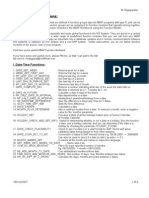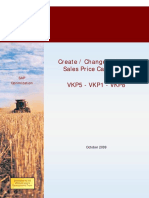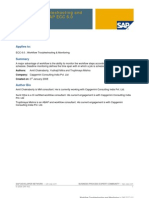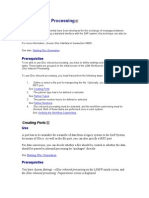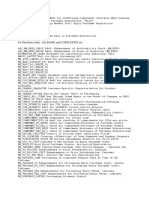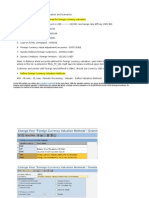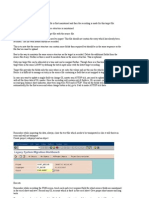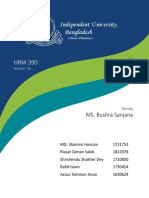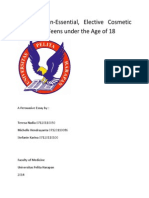Sap Implementation Phases
Sap Implementation Phases
Uploaded by
neelam618Copyright:
Available Formats
Sap Implementation Phases
Sap Implementation Phases
Uploaded by
neelam618Original Description:
Original Title
Copyright
Available Formats
Share this document
Did you find this document useful?
Is this content inappropriate?
Copyright:
Available Formats
Sap Implementation Phases
Sap Implementation Phases
Uploaded by
neelam618Copyright:
Available Formats
New company code Implementation Continuous Improvement Phase only (if Your Landscape (DEV, QAS and PRD
) already Implemented ).
Continuous Improvement Phase Towards continuous improvement and to overcome the organizational, business & technology changes the followings are covered under this phase:
Post go-Live Support Improve System performance
SAP Implementation Phases Project Preparation Phase As per Accelerated SAP (ASAP) methodology it is the First Phase of SAP Implementation. During this phase, following components are discussed and documented: * * * * * * Initial Project Planning Project Procedures Project Team Members & their Training Project Kickoff Technical Requirements Quality Check
Business Blueprint Phase - In this phase, a detailed study of business processes and business requirements are undertaken by the Project Team members. This is the phase where Project Team Members interact with respective Core Team Members or Process Owners. The entire requirements gathered during this phase are documented as Business Blueprint. During this phase, following components are discussed and documented: * * * * * * * * Project Management Organizational Change Management Training Develop System Environment Organizational Structure Definition Business Process Analysis Business Process Definition Quality Check
Realization Phase - In this phase, all the business and process requirements are implemented as documented in Business Blueprint. SAP R/3 system is configured step by step in two work packages, Baseline and Final configuration. How these configurations will be done and how it will be tested.
* * * * * * * * *
Baseline Configuration and Confirmation System Management Final Configuration and Confirmation Development of external Programs & Interfaces Unit Testing & Documentation Final Integration Test Business Scenarios & Process Documentation End User Training & Documentation Quality Check
Final Preparation Phase - During this phase, following activities are discussed, completed and documented, successful completion of these activities leads to transition of all configurations settings to live R/3 System * * * * * System Management Stress & Volume Tests Cutover Strategies & Plans End User Training Quality Check
Go Live and Support Phase This is phase where all configurations/customizations are transported to live production operation and business starts all its activities in the SAP R/3. During this phase, all the problems/issues related to hardware, network, operating system, database, training, and application system are addressed by the project team members and they help the end users in achieving their day to day task/assignments. This phase is further divided as: * Application Production Support and Maintenance * Project Implementation End Continuous Improvement Phase Towards continuous improvement and to overcome the organizational, business & technology changes the followings are covered under this phase: * Post go-Live Support * Improve System performance
SAFARI Project preparation is the first and initial phase of the ASAP roadmap wherein you just start the project. You will perform activities such as preparation of the initial scope, high-level timelines and plans, project charters, identification of project team members, project kick-off, etc.
Business blueprint is the second phase in the implementation where you identify, and document business requirements and goals to prepare the foundation for future stages of the project. Ideally, you will organize business Requirement gathering workshops with the various business/functional users of the company, lead them through the discussion with structured business functionality questionnaires, understand their existing business processes, and identify and document their requirements in the wake of this new implementation. A sign-off at the end of the phase ensures an agreement to move forward outlining the scope of the project. It is understood that whatever is explicitly stated in the business blueprint document is the only scope; no implied scope will be considered for system configuration in the next phase.
Realization is the third phase where the implementing team breaks down the Business processes identified in the second phase and configures the SAP settings. Initially, you will do a Baseline Configuration, test the system functionality and if necessary make changes to the baseline configuration, and close the phase with
Final Configuration, signaling that all the business processes have been captured and configured in the system.
Final Preparation is the penultimate phase in the project. This phase also serves to resolve all crucial open issues. A go-live check is also conducted to analyze whether the system has been properly configured. This phase is marked by the following activities: End-to-end testing of the configured system (User Acceptance Test - UAT) Training of the end users (Usually follows the following activities: End-to-testing of the configured system (User Acceptance Test - UAT) Training of the end users (Usually follows the concept Train-the-Trainer)
What are User Parameters? SAP provides a way of lessening your day-to-day data entry operations by facilitating default entries for fields, and bringing out the most suitable Display Variant for document display, document entry, open/line item processing, etc. The user parameters, also known as Editing Options, are a boon as they save time and result in greater accuracy as data entry errors are eliminated with the default values. You can, among many alternatives, set: 1. The system to default the exchange rate from the first line item. 2. A preference so that the user does not process any special GL transactions or foreign currency transactions. 3. That the document needs to be complete before it is parked. 4. The system to calculate the tax component on the net invoice and not on the gross.
5. Your document currency either as the local currency or as the one used in the last document. the gross. 5. Your document currency either as the local currency or as the one used in the last document. FI-SL Special Purpose Ledger This submodule is used to provide the summary information from multiple applications at a level of detail that the user defines. FI-LC Legal Consolidations This submodule helps in the central task of combining the financial operating results of the companies within a group to provide overall results for the group.
You might also like
- Annual Student Outcome Goal-College and CareerDocument2 pagesAnnual Student Outcome Goal-College and Careerapi-541780240100% (1)
- Motivation Concepts Table Week 1Document4 pagesMotivation Concepts Table Week 1aspurlock_420No ratings yet
- Interview Questions For s4HANADocument6 pagesInterview Questions For s4HANAVidya Dsouza83% (6)
- SOP SAP Note Implementation PDFDocument13 pagesSOP SAP Note Implementation PDFrg100% (1)
- How To Configure Fiori Tile Step by Step Part1 PDFDocument92 pagesHow To Configure Fiori Tile Step by Step Part1 PDFbhavana amarNo ratings yet
- SAP Business ByDesign Introduction To Customer Language Adaptation Version April2017 Part3Document16 pagesSAP Business ByDesign Introduction To Customer Language Adaptation Version April2017 Part3Abhishek NandiNo ratings yet
- Interview Questions and Answers For SAP Project ImplementationDocument8 pagesInterview Questions and Answers For SAP Project ImplementationRyan CheungNo ratings yet
- OMRT - Account Key UssageDocument16 pagesOMRT - Account Key Ussageneelam618No ratings yet
- Foreign Language: Nihongo (Foreign Lang 11) : A Module inDocument5 pagesForeign Language: Nihongo (Foreign Lang 11) : A Module injohnford florida100% (1)
- Practical Workflow For SapDocument12 pagesPractical Workflow For SapRobson Gil2100% (1)
- Details - SAP - 12082016Document18 pagesDetails - SAP - 12082016Vikash TiwariNo ratings yet
- S4 HANA SimplificationDocument10 pagesS4 HANA SimplificationTapas KunduNo ratings yet
- Important ABAP Functions - 29oct2007Document6 pagesImportant ABAP Functions - 29oct2007api-3836423100% (1)
- Sap-Sd Pricing Condition Technique & Pricing Procedure DetermniationDocument33 pagesSap-Sd Pricing Condition Technique & Pricing Procedure DetermniationLaxmi Narsimha Rao Mamidala100% (1)
- Sap SD - Create, Change, Display Price Calculation PDFDocument18 pagesSap SD - Create, Change, Display Price Calculation PDFsuku_mcaNo ratings yet
- Sap ScriptDocument39 pagesSap Scriptbqueli22No ratings yet
- SAP Workflow Customization SettingsDocument35 pagesSAP Workflow Customization SettingsMurthy Vanka100% (2)
- RICEF MeansDocument42 pagesRICEF MeansAdaikalam Alexander RayappaNo ratings yet
- Consuming WebServices Directly From ABAP - SAP BlogsDocument13 pagesConsuming WebServices Directly From ABAP - SAP BlogsCarlos Eduardo Fonseca da SilvaNo ratings yet
- BPP Sap ExampleDocument25 pagesBPP Sap ExampleBolpaur68100% (1)
- FI SD Integration in SAP Interview Questions & AnswersDocument7 pagesFI SD Integration in SAP Interview Questions & AnswerssjobsvnNo ratings yet
- Effective Management of RICEF Development On SAP ProjectsDocument5 pagesEffective Management of RICEF Development On SAP ProjectsNaveen KumarNo ratings yet
- Sap Workflow TrainingDocument85 pagesSap Workflow Trainingvarghese200767% (3)
- Migration To Simple FinanceDocument15 pagesMigration To Simple Financeganesanmani1985No ratings yet
- Composite Role Creation in SAPDocument38 pagesComposite Role Creation in SAPRanjithNo ratings yet
- 3 SAP SD Level-1 TrainingDocument38 pages3 SAP SD Level-1 TrainingkalykumNo ratings yet
- TOR in Sales and Distribution (SAP - SD) DocumentsDocument3 pagesTOR in Sales and Distribution (SAP - SD) DocumentspraveennbsNo ratings yet
- SAP Service Configurations - SAP MMDocument11 pagesSAP Service Configurations - SAP MMbeema1977No ratings yet
- Sap MRSDocument6 pagesSap MRSRaghavendraMuruganNo ratings yet
- Ticket System in Support Projects SAP ABAP Consultants - SAP ABAP Consultant - SapnutsDocument4 pagesTicket System in Support Projects SAP ABAP Consultants - SAP ABAP Consultant - SapnutsneelNo ratings yet
- ABAP Performance and Best Practices A Bible V1 0Document77 pagesABAP Performance and Best Practices A Bible V1 0Harshal Joshi100% (1)
- SAP Basics InterviewDocument72 pagesSAP Basics InterviewReddaveni NagarajuNo ratings yet
- SAP WorkFlow Interview Questions and AnswersDocument2 pagesSAP WorkFlow Interview Questions and Answerssivac2wkumarNo ratings yet
- eCATT TutorialDocument27 pageseCATT Tutorialkumaran_kadsNo ratings yet
- SAP Testing Roles and ResponsibilitiesDocument1 pageSAP Testing Roles and Responsibilitiessaisuni.mNo ratings yet
- SAP Standard Authorization Roles of Personnel ManagementDocument3 pagesSAP Standard Authorization Roles of Personnel ManagementaijlalNo ratings yet
- SAP UI5, SAPUI5, SAP Fiori, SAP HTML5, SAP OData, SAPUX, SAPX03, SAPX04, SAPX05, GW100 PDFDocument1 pageSAP UI5, SAPUI5, SAP Fiori, SAP HTML5, SAP OData, SAPUX, SAPX03, SAPX04, SAPX05, GW100 PDFSAP MaterialsNo ratings yet
- ALE & IDOCS Step by StepDocument47 pagesALE & IDOCS Step by StepnileshforyouNo ratings yet
- SAP Implementation Project, Rollout Project, Supporting Project, Upgrading Project - SAP Blogs PDFDocument7 pagesSAP Implementation Project, Rollout Project, Supporting Project, Upgrading Project - SAP Blogs PDFr k100% (1)
- SAP S/$4 Hana Project: User CommunityDocument44 pagesSAP S/$4 Hana Project: User Communityroyjoy100% (1)
- ERP - Enterprise Resource Planning: HistoryDocument10 pagesERP - Enterprise Resource Planning: HistoryNaga Mahendra100% (1)
- SAP PI - PO Tutorial - Process Integration & OrchestrationDocument12 pagesSAP PI - PO Tutorial - Process Integration & Orchestrationphogat projectNo ratings yet
- Function Specifications in SAPDocument6 pagesFunction Specifications in SAPRamesh BalajiNo ratings yet
- LSMW StepsDocument10 pagesLSMW Stepsapi-25919427100% (1)
- Sap Enhancements Exits and Badi OverviewDocument107 pagesSap Enhancements Exits and Badi OverviewquyenhuynhhaNo ratings yet
- How To Develop ABAP RICEF Objects in SDocument23 pagesHow To Develop ABAP RICEF Objects in SAdaikalam Alexander Rayappa50% (2)
- BRF Plus-A Real Time Example - SAP BlogsDocument20 pagesBRF Plus-A Real Time Example - SAP Blogscharu.hitechrobot2889No ratings yet
- Screen EXIT in SAP ABAP BY Prakash SwayamDocument8 pagesScreen EXIT in SAP ABAP BY Prakash SwayamswayamNo ratings yet
- SAP ABAP EnhancementsDocument70 pagesSAP ABAP EnhancementsAnonymous zzw4hoFvHNNo ratings yet
- Workflow Troubleshooting and Monitoring in SAP ECC 6.0Document21 pagesWorkflow Troubleshooting and Monitoring in SAP ECC 6.0migonetiNo ratings yet
- LSMW-IDoc Inbound ProcessingDocument19 pagesLSMW-IDoc Inbound ProcessingSzabolcs KovácsNo ratings yet
- SAP Smart Forms: by Yashbir Singh/Krishna PrasadDocument37 pagesSAP Smart Forms: by Yashbir Singh/Krishna PrasadKumar Krishna KumarNo ratings yet
- List of Badi in PoDocument5 pagesList of Badi in PoNiranjan Behera100% (1)
- SAP SD Tutorial - Sales & Distribution (SAP SD) Module TrainingDocument5 pagesSAP SD Tutorial - Sales & Distribution (SAP SD) Module Trainingnaveen reddyNo ratings yet
- IDOCDocument18 pagesIDOCÂrimȃ Herzlos100% (2)
- Foreign Currency ValuationDocument21 pagesForeign Currency Valuationneelam618No ratings yet
- Period End Closing ActivitiesDocument2 pagesPeriod End Closing Activitiesneelam618No ratings yet
- Period End Closing ActivitiesDocument2 pagesPeriod End Closing Activitiesneelam618No ratings yet
- LSMWDocument25 pagesLSMWneelam618No ratings yet
- Itil Service Life Cycle-OwnDocument1 pageItil Service Life Cycle-Ownneelam618No ratings yet
- Lesson - 1 To 8Document181 pagesLesson - 1 To 8sagartarun1113No ratings yet
- Visibility Analysis - 2023Document17 pagesVisibility Analysis - 2023PENEHAFO ITHANANo ratings yet
- List of Subjects /no. of Modules/Pages: First QuarterDocument1 pageList of Subjects /no. of Modules/Pages: First QuarterJM JavienNo ratings yet
- DIGM4375: Packaging Design: Spring 2017Document9 pagesDIGM4375: Packaging Design: Spring 2017Anonymous fJ0nUP0L3No ratings yet
- Independent University, Bangladesh: Team ExileDocument37 pagesIndependent University, Bangladesh: Team ExileNafees hasanNo ratings yet
- Sensors 22 06463 v2Document33 pagesSensors 22 06463 v2sami salehNo ratings yet
- Rajesh Aws Resume3Document3 pagesRajesh Aws Resume3ADITYA REDDY MEKALANo ratings yet
- CalendarDocument62 pagesCalendarsant_shivNo ratings yet
- B.ed 115Document5 pagesB.ed 115jf4714302No ratings yet
- CV Nabil FauzanDocument2 pagesCV Nabil Fauzandaud sibaraniNo ratings yet
- Lesson 8Document25 pagesLesson 8dariusjohnpaulmiraflorNo ratings yet
- Banning Non-Essential, Elective Cosmetic Surgery For Teens Under The Age of 18Document4 pagesBanning Non-Essential, Elective Cosmetic Surgery For Teens Under The Age of 18Stefanie KarinaNo ratings yet
- Creating Multiliangual Site Joomla3Document17 pagesCreating Multiliangual Site Joomla3Batik KataNo ratings yet
- Mechanical Design Engineer Resume Cover LetterDocument5 pagesMechanical Design Engineer Resume Cover Letterafdnaqllu100% (1)
- Solution Prob2Document2 pagesSolution Prob2Durba Binte KalamNo ratings yet
- Network Management KPI'sDocument66 pagesNetwork Management KPI'sFurqan Ali KhanNo ratings yet
- Manual de Sistemas EducativosDocument127 pagesManual de Sistemas EducativosdariocosteNo ratings yet
- Gulayan Sa Paaralan and Its Implication To Learners' Nutritional Status and Academic PerformanceDocument14 pagesGulayan Sa Paaralan and Its Implication To Learners' Nutritional Status and Academic PerformanceGlobal Research and Development Services100% (1)
- DPS Annual Report Card - District K-3 LiteracyDocument2 pagesDPS Annual Report Card - District K-3 LiteracyChristina SchaeferNo ratings yet
- A Thesis Manuscript of Group 5 Complete 3Document87 pagesA Thesis Manuscript of Group 5 Complete 3Ana MarieNo ratings yet
- Is Kierkegaard Still Relevant TodayDocument2 pagesIs Kierkegaard Still Relevant TodayStanisław KsiążkiewiczNo ratings yet
- Paraphrasing PowerpointDocument26 pagesParaphrasing PowerpointHeidi TieuNo ratings yet
- Adams 2013.1 Doc InstallDocument114 pagesAdams 2013.1 Doc InstallSaeed GhaffariNo ratings yet
- PROFESSIONAL EDUCATION Let ReviewDocument22 pagesPROFESSIONAL EDUCATION Let ReviewVic Gerome Dela CruzNo ratings yet
- EIT Course Mechanical Design Concepts For Non Engineers CMW BrochureDocument3 pagesEIT Course Mechanical Design Concepts For Non Engineers CMW BrochurepratNo ratings yet
- Submission:: Peer Evaluation FormDocument2 pagesSubmission:: Peer Evaluation FormMahalaleel QuilantangNo ratings yet
- Daniel MeeksDocument2 pagesDaniel MeeksDaniel Aaron MeeksNo ratings yet
















